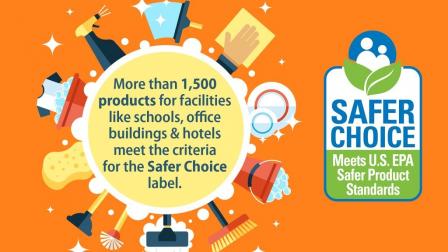EPA Highlights for the Week of May 2, 2016

- May is Asthma Awareness Month
- Safer Choice Partner of the Year Award Winners Announced
- New Tool Helps Communities Assess Economic Impacts of Climate Change
- On the Ground in Flint: How We're Partnering With the Community
May is Asthma Awareness Month
 Children are the most vulnerable - asthma is the leading cause of school absenteeism.24 million Americans suffer from asthma; air pollution can trigger asthma attacks. May is Asthma Awareness Month and EPA is supporting local programs to help communities bring asthma under control. In order to help maintain active lifestyles and control symptoms, sufferers from asthma can: identify and avoid environmental asthma triggers; create an Asthma Action Plan and get local air quality conditions.
Children are the most vulnerable - asthma is the leading cause of school absenteeism.24 million Americans suffer from asthma; air pollution can trigger asthma attacks. May is Asthma Awareness Month and EPA is supporting local programs to help communities bring asthma under control. In order to help maintain active lifestyles and control symptoms, sufferers from asthma can: identify and avoid environmental asthma triggers; create an Asthma Action Plan and get local air quality conditions.
Reduce your contribution to air pollution by walking, biking, and taking public transportation to limit driving. At home, work, and school, turn out lights when not in use to reduce pollution from energy production. It will help you save money, too. Check out more tips on how to reduce your contribution to air pollution.
Follow these 10 steps (PDF) and watch a video seriesExit to make your home asthma-friendly.
Safer Choice Partner of the Year Award Winners Announced
 Safer Choice empowers consumers to protect their health and minimize impact on the environment.EPA's Safer Choice program helps consumers and commercial buyers easily find cleaning and other products made with ingredients that are safer for human health and the environment. Ingredients in products with the Safer Choice label meet EPA's stringent standards for safety and performance.
Safer Choice empowers consumers to protect their health and minimize impact on the environment.EPA's Safer Choice program helps consumers and commercial buyers easily find cleaning and other products made with ingredients that are safer for human health and the environment. Ingredients in products with the Safer Choice label meet EPA's stringent standards for safety and performance.
This year, EPA is honoring 24 organizations with Partner of the Year Awards. These organizations actively advance the goal of chemical safety through exemplary participation in, or promotion of, Safer Choice.
Learn more about the 2016 Award winners.
New Tool Helps Communities Assess Economic Impacts of Climate Change
 It is crucial for communities to build economies that can withstand extreme weather events.Having a climate-resilient economy that can withstand or quickly recover from climate change impacts is essential to a community's well-being. EPA worked with the Rhode Island Division of Panning to develop a Planning Framework for a Climate-Resilient Economy (PDF) to help communities assess how climate change might affect their economy and how to improve their economic resilience.
It is crucial for communities to build economies that can withstand extreme weather events.Having a climate-resilient economy that can withstand or quickly recover from climate change impacts is essential to a community's well-being. EPA worked with the Rhode Island Division of Panning to develop a Planning Framework for a Climate-Resilient Economy (PDF) to help communities assess how climate change might affect their economy and how to improve their economic resilience.
Communities can adapt the framework, which is designed to be flexible so communities with varying levels of analytical expertise, time, and funds are able to use it. Learn more about the framework and other information about how communities can use smart growth strategies to address climate change.
On The Ground in Flint: How We're Partnering with the Community
 Our team is in Flint and we’re not leaving until we get the water system back on track.EPA has been working with HHS and other federal agencies to help restore safe drinking water in Flint, MI. We've partnered with local community organizations on door-to-door canvassing and have passed out thousands of fact sheets for residents.
Our team is in Flint and we’re not leaving until we get the water system back on track.EPA has been working with HHS and other federal agencies to help restore safe drinking water in Flint, MI. We've partnered with local community organizations on door-to-door canvassing and have passed out thousands of fact sheets for residents.
Lead can enter drinking water through corrosion of plumbing pipes and fixtures, especially where the water has high acidity or low mineral content. Children under the age of six are most vulnerable to the health effects of lead.
EPA, the state of Michigan, and the city of Flint recently announced #FlushforFlint (PDF) campaign. Residents are encouraged to run water from their kitchen sinks and bathroom tubs for 5 minutes each day for 14 straight days during the month of May. Flushing the pipes is very important to remove loose lead particles and to coat the pipes. The State of Michigan is paying for the program and credit will be added to residents’ water bills.
Read a blog post by Micah Ragland, EPA’s Associate Administrator for Public Engagement and Environmental Education, on how we are partnering with communities in Flint.
You may need a PDF reader to view some of the files on this page. See EPA’s About PDF page to learn more.
